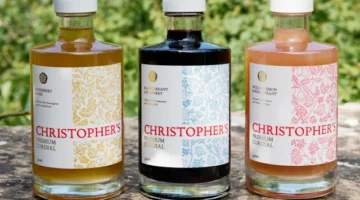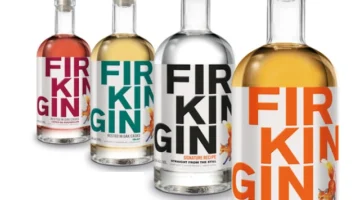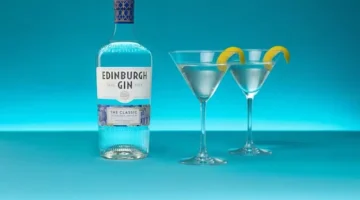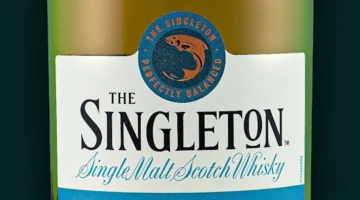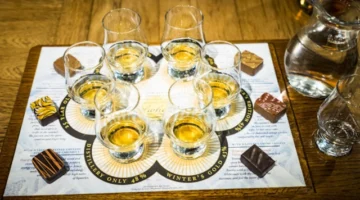The Story of the Martini
Travel Distilled tells the story of the Martini, the classic cocktail thought to have originated in San Francisco in the 19th century.

The martini, a cocktail synonymous with sophistication and timeless elegance, boasts a history as complex and intriguing as its flavor profile. While its exact origins remain shrouded in mystery, several different narratives contribute to the rich tapestry of the martini’s story.
The Martinez Connection
One popular theory suggests that the martini evolved from a precursor known as the Martinez. This cocktail, believed to have originated in San Francisco during the mid-19th century, featured Old Tom gin (a sweeter, less dry style of gin), sweet vermouth, maraschino liqueur, and bitters. As tastes evolved, the Martinez gradually transformed, with the sweeter Old Tom gin giving way to the drier London Dry gin, and the proportions of gin to vermouth shifting to create a drier, more assertive drink.
The Vermouth Influence
Another story links the martini’s name to the Italian vermouth brand Martini & Rossi. As dry vermouth gained popularity in the late 19th century, it became a key ingredient in the evolving martini recipe. The association between the cocktail and the vermouth brand may have led to the drink being named simply “Martini.”
The Knickerbocker Hotel Legend
A more romantic tale attributes the martini’s creation to a bartender named Martini di Arma di Taggia at New York’s Knickerbocker Hotel in the early 20th century. According to this legend, Martini crafted the cocktail for none other than John D. Rockefeller, the renowned business magnate. While this story adds a touch of glamour to the martini’s history, its accuracy remains uncertain.
The Rise of the Dry Martini
As the 20th century progressed, the martini continued to evolve, with a growing preference for drier variations. The ratio of gin to vermouth steadily increased, resulting in a cocktail that emphasized the botanical notes of the gin while minimizing the sweetness of the vermouth. The addition of a lemon twist or an olive as a garnish further contributed to the martini’s signature dryness.
The Martini in Popular Culture
The martini’s popularity soared in the mid-20th century, becoming a symbol of sophistication and urbanity. The “three-martini lunch” became a fixture in business culture, and the martini made frequent appearances in literature, film, and television. James Bond’s iconic “shaken, not stirred” martini in the 007 films further cemented the cocktail’s place in popular culture.
The Martini Today
Today, the martini remains a beloved classic, enjoyed by cocktail enthusiasts around the world. While the traditional gin martini with a lemon twist or olive garnish remains a popular choice, bartenders continue to innovate, creating new and exciting variations on this timeless cocktail. From the use of different gins and vermouths to the addition of unique ingredients and garnishes, the martini continues to inspire creativity and experimentation.
Three Martini Cocktail Recipes You Should Know
Here are three different martini cocktail recipes, ranging from the classic to a couple of popular variations:
- The Classic Dry Martini
This is the quintessential martini, elegant and strong.
- Ingredients:
- 5 oz Gin (London Dry is traditional)
- 5 oz Dry Vermouth (e.g., Dolin, Noilly Prat)
- Lemon twist or olives for garnish
- Ice
- Instructions:
- Fill a mixing glass with ice.
- Add the gin and dry vermouth.
- Stir well for about 30 seconds until thoroughly chilled. (Stirring is preferred for martinis as it keeps the drink clear and avoids over-dilution from shaking.)
- Strain into a chilled martini glass.
- Garnish with a lemon twist (expressed over the drink to release oils) or 1-3 olives.
- Notes:
- Gin vs. Vodka: While gin is traditional, many prefer a vodka martini. Simply substitute vodka for gin.
- Vermouth Ratio: The vermouth ratio can be adjusted to taste. Some prefer “extra dry” with just a whisper of vermouth, while others like a “wet” martini with more.
- Olive Brine: For a “dirty martini,” add a splash (1/4 to 1/2 oz) of olive brine to the mixing glass.
- The Espresso Martini
A popular modern classic, perfect for a pick-me-up.
- Ingredients:
- 5 oz Vodka
- 1 oz Coffee Liqueur (e.g., Kahlúa, Tia Maria)
- 1 oz Freshly Brewed Espresso (chilled)
- 5 oz Simple Syrup (optional, to taste, for sweetness)
- Coffee beans for garnish
- Ice
- Instructions:
- Add all ingredients (vodka, coffee liqueur, chilled espresso, and simple syrup if using) to a cocktail shaker filled with ice.
- Shake vigorously for 15-20 seconds until well-chilled and a frothy head forms.
- Double strain into a chilled martini glass (using a fine-mesh sieve in addition to your shaker’s strainer to catch any ice shards or coffee grounds).
- Garnish with 3 coffee beans floating on the foam.
- Notes:
- Fresh Espresso: Freshly brewed and chilled espresso is key for the best flavor and foam.
- Sweetness: Adjust the simple syrup to your preferred level of sweetness.
Famous from James Bond’s Casino Royale, this martini uses both gin and vodka, with a unique vermouth.
- Ingredients:
- 3 oz Gin (preferably Gordon’s, as specified by Bond, or a similar juniper-forward gin)
- 1 oz Vodka (grain-based)
- 5 oz Lillet Blanc (a French aperitif wine, not a traditional vermouth but used here)
- Large lemon peel for garnish
- Ice
- Instructions:
- Add the gin, vodka, and Lillet Blanc to a cocktail shaker filled with ice.
- Shake very well until thoroughly chilled. (Bond famously insisted on it being “shaken, not stirred.”)
- Strain into a chilled deep champagne goblet (Bond’s preferred glass) or a martini glass.
- Garnish with a large, thin slice of lemon peel, expressed over the drink to release its oils.
- Notes:
- “Three measures of Gordon’s, one of vodka, half a measure of Kina Lillet.” Kina Lillet is no longer produced; Lillet Blanc is its closest modern equivalent, though it’s less bitter.
- Shaken: While most martinis are stirred, the Vesper is explicitly shaken. This does result in more dilution and a slightly cloudier appearance, but it’s part of its iconic preparation.
Enjoy experimenting with these different martini styles!



